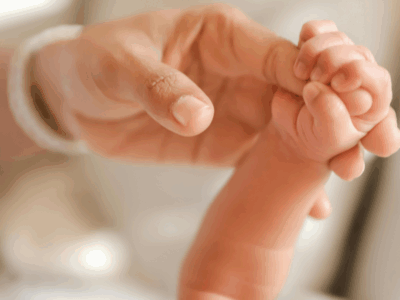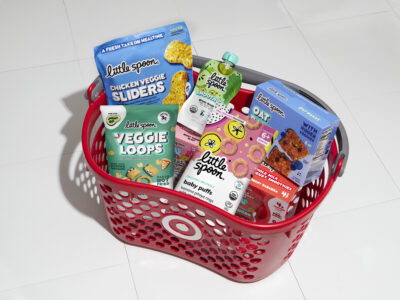If you’re wondering what comes after the pureé stage or how small (or big) you should be cutting your 9+ month old’s transition-to-table food and baby-led weaning meals…we’ve been there. That’s why Little Spoon launched their Biteables product line. To make you and your kiddo’s lives easier, less stressful and a whole lot tastier.
So, what are Biteables?
- A line of early finger foods, meant for babies usually between 9-16 months
- Meals in cut-to-size pieces to support your baby’s motor and oral skills
- A stress-free solution for transitioning to table foods or the next stage of baby-led weaning
- Veggie + protein-packed, clean and balanced recipes
- Unique ingredients to help prevent picky eating and expand your baby’s palate
How do you know if your baby is ready for Biteables?
Your kiddo will start to show signs of readiness such as reaching for objects, sitting independently, opening and closing their fingers repetitively and more (a sign that pincer grasp is ready to get put to work!).
Are Biteables meant for baby-led weaning?
Yes, this is a safe way to introduce the next stage in your baby’s BLW journey without stress. Around 9+ months, your baby may be ready for smaller, bite-sized pieces of food that are pinchable, mashable and softer in texture. Self-feeding allows your baby to explore new textures, tastes and smells at their own pace while developing their hand-eye coordination and other skills.
Why should my baby-self feed?
Self-feeding encourages independence that helps develop your little one’s confidence and bravery in a range of situations.
- Serving cut-to-size meals like Biteables helps the development of fine motor skills that primes your kiddo to be more nimble and strengthen the use of their hands.
- Transitioning-to-table foods offers your mini a whole new range of flavors and textures that help expand your babe’s palate, their sense of taste and preference for certain foods.
- Finally, self-feeding offers a way for your mini to become more observant. Since they are in control of how much they are consuming, they’ll know when to stop and when they want more.
Does the Biteables line accommodate dietary preferences?
Heck yes! Check out the line up:
- Coconut is currently the only tree-nut allergen found in some products, like the Mini Beef Ravioli.
- For the egg and dairy free kiddos, we got you covered with Shredded Fajita Chicken, Rosemary Chicken, and Oven Baked Sausage w/ BBQ Sauce
- Is your kiddo a veggie lover? The Mini Cheesy Pasta and Mini White Mac and Cheese are perfect options.
- If gluten hurts your mini’s tummy, then the Turkey Kale Meatballs, Pesto Eggs and Oven Baked Sausage w/ BBQ Sauce will be their best friends.
- For the meat lovers, Little Spoon has 100% USA Grass-Fed Beef Meatballs, Mini Beef Ravioli and Roast Turkey and Gravy too!
How do I know that it’s safe for my baby to eat bite-sized pieces of food?
Choking is one of the most common fears parents have when introducing finger foods and transitioning to table foods.
Little Spoon Biteables are cut to the appropriate size and cooked to be soft for this important stage. The general rule is, if you can mash it between your thumb and forefinger your child can mash it with their gums- no teeth required!
However, there are other important steps you can take to reduce the risk of choking:
- Always supervise your baby when they are eating, even if they are able to feed themselves. Keep a close eye on them at all times.
- Encourage your baby to chew their food by modeling chewing motions and giving them time to work on each bite before offering another.
- Avoid foods that are small, hard, sticky, or round since these are more likely to cause risk. Things like popcorn, nuts, grapes, or soft bread that can gum together.
- It’s also a good idea to know what to do in case of choking. Take a course in infant and child CPR or choking rescue so that you are prepared to act quickly if needed. Being prepared will help reduce your anxiety.
Are Biteables tested for heavy metals?
They sure are! In November 2024, we set out to make a BIG change not just for Little Spoon, but the entire baby food industry because there are currently no federal regulations in the U.S. Therefore, we took matters into our own hands and developed standards inspired by the European Union (EU) limits on 500+ toxins and contaminants, including heavy metals, plasticizers and pesticides. Our Babyblends, Puffs, Baby Cereal, Biteables, Smoothies +YoGos have publicly available testing standards viewable on our site and we promise that no product will be sold unless it meets our rigorous standards, period. Our commitment makes it possible for families to trust the foods that their kiddo is eating as they start solids and graduate from our Babyblends and move on to a stress-free transition to finger foods.
Remember that every baby is different, and it is important to monitor your child’s development and adjust your feeding approach as necessary. Always work with your pediatrician on the right plan for your kiddo. Don’t push finger foods if you aren’t seeing the signs that your little one is ready, and don’t put it off because you’re scared. You got this!
The TDLR is, Biteables are a great option for your kiddo if they are in that “in-between” eating stage, on the baby-led weaning path or somewhere in between. Little Spoon makes it easy for parents to enter these new eating stages without the stress— from the pureé stage to early finger food meals to your kiddo’s toddler + big kid years. And don’t forget the snacks! Mealtime can be easy and a lot of fun— transitioning-to-table foods is another milestone on your mini’s journey.



